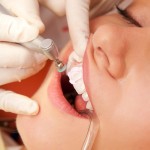
An update of the Cochrane review on routine scale and polish is now available. Scaling and polishing is provided by dentists or hygienists at regular intervals. It is often a regular component of ‘a dental checkup’ whether or not a patient is at risk of developing periodontal disease. The objectives were:-
- to determine the beneficial and harmful effects of routine scaling and polishing for periodontal health;
- to determine the beneficial and harmful effects of providing routine scaling and polishing at different time intervals on periodontal health;
- to compare the effects of routine scaling and polishing with or without oral hygiene instruction (OHI) on periodontal health; and
- to compare the effects of routine scaling and polishing provided by a dentist or dental care professional (dental therapist or dental hygienist) on periodontal health.
The usual robust Cochrane methodological approaches were taken for the review.
- Three randomised controlled trials with a total of 836 patients were included . All 3 had unclear risk of bias.
- No studies reported any adverse effects and No studies were found which compared the effects of routine scaling and polishing provided by a dentist or dental care professional (dental therapist or dental hygienist) on periodontal health.
- Only one trial provided data for the comparison between scale and polish versus no scale and polish. It found no evidence to claim or refute benefit for scale and polish treatments for the outcomes of gingivitis, calculus and plaque.
- Two studies compared routine scale and polish provided at different time intervals.When comparing six with 12 months there was insufficient evidence to determine a difference for gingivitis at 24 months. There were some statistically significant differences in favour of scaling and polishing provided at more frequent intervals, in particular between three and 12 months for the outcome of gingivitis at 24 months, based on one study. There was some evidence of a reduction in calculus. This body of evidence was assessed as of low quality.
- One study provided data for the comparison of scale and polish treatment with and without OHI. There was a reduction in gingivitis for the 12-month scale and polish treatment when assessed at 24 in favour of including OHI. There were also significant reductions in plaque for both three and 12-month scale and polish treatments when OHI was included. The body of evidence was once again assessed as of low quality.
The authors concluded
There is insufficient evidence to determine the effects of routine scale and polish treatments. High quality trials conducted in general dental practice settings with sufficiently long follow-up periods (five years or more) are required to address the objectives of this review.
Comments
This latest update to this review has added one new study and has amended inclusion criteria to exclude patients with severe periodontitis and split-mouth studies and studies that only included a single visits for scale and polish. The review also included new methods of assessing risk of bias. Given that significant resources are expended on providing routine scale and polish in primary care it is disappointing that there remains insufficient good quality evidence to determine the benefits and risks to patients. The authors note one ongoing multi-centre randomised trial in the UK http://www.controlled-trials.com/ISRCTN56465715
Links
Worthington HV, Clarkson JE, Bryan G, Beirne PV. Routine scale and polish for periodontal health in adults. Cochrane Database of Systematic Reviews 2013, Issue 11. Art. No.: CD004625. DOI: 10.1002/14651858.CD004625.pub4.

“@TheDentalElf: Insufficient evidence to determine the effects of routine scale and polish treatments http://t.co/rgEHogAfEa”